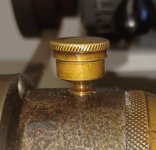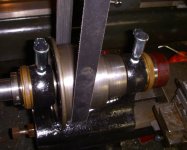MrStretch
Hot Rolled
- Joined
- Mar 20, 2017
Hello all,
I am curious about the differences between the headstock oil cups on my 2 Stark #4 plain turning lathes. The newer one from the 1920's which I've owned and used for years has very close fitting lids ( make a "pop" when removed ) and an internal stand pipe


I have always filled up the standpipes & cups with oil whenever I start using it which is relatively infrequently. The oil is definitely being drawn from the cup into and out of the bearings (aka leaking all the time ), so I never really gave it much thought.
My new to me and older Stark #4 has the same kind of bearings but the oil cups have heavy loose fitting lids and no standpipes


I think that I need to maybe to plug the stem with a small bit of felt or something so the oil drips thru or perhaps it's fine as it is because you can't over-oil it?
PS - it's cleaner than it looks in the pics. The cap was originally plated.
I am curious about the differences between the headstock oil cups on my 2 Stark #4 plain turning lathes. The newer one from the 1920's which I've owned and used for years has very close fitting lids ( make a "pop" when removed ) and an internal stand pipe


I have always filled up the standpipes & cups with oil whenever I start using it which is relatively infrequently. The oil is definitely being drawn from the cup into and out of the bearings (aka leaking all the time ), so I never really gave it much thought.
My new to me and older Stark #4 has the same kind of bearings but the oil cups have heavy loose fitting lids and no standpipes


I think that I need to maybe to plug the stem with a small bit of felt or something so the oil drips thru or perhaps it's fine as it is because you can't over-oil it?
PS - it's cleaner than it looks in the pics. The cap was originally plated.




